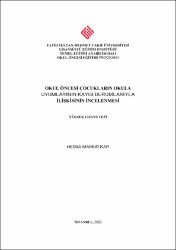Okul Öncesi Çocukların Okula Uyumlarının Kaygı Durumlarıyla İlişkisinin İncelenmesi
Künye
KAR, Hesna MAMUR, Okul Öncesi Çocukların Okula Uyumlarının Kaygı Durumlarıyla İlişkisinin İncelenmesi, Fatih Sultan Mehmet Vakıf Üniversitesi Lisansüstü Eğitim Enstitüsü Temel Eğitim Anabilim Dalı Okul Öncesi Eğitimi Programı,Yayımlanmamış Yüksek Lisans Tezi, İstanbul 2022Özet
Bu araştırmada okul öncesi çocukların okula uyum düzeyleri ile kaygı durumları arasındaki ilişkinin incelenmesi amaçlanmıştır. Araştırma ilişkisel tarama modeli ile gerçekleştirilmiştir. Araştırmanın çalışma grubunu Tunceli ilindeki Milli Eğitim Bakanlığına bağlı anaokullarındaki 36-72 aylık 550 çocuk oluşturmuştur. Araştırmada veri toplama aracı olarak; “İlk Günlerde Okula Uyum Ölçeği” ve “Okul Öncesi Çocuklarda Anksiyete (Kaygı) Ölçeği (Öğretmen Formu)” kullanmıştır. “İlk Günlerde Okula Uyum Ölçeği”, sosyal uyum, kurallara uyum, davranış uyumu olmak üzere 3 alt boyuttan, “Okul Öncesi Çocuklarda Anksiyete (Kaygı) Ölçeği (Öğretmen Formu)” tek alt boyuttan oluşmaktadır. Normallik testi uygulanmış ve veriler normal dağılım göstermediği (p<0.05) belirlenmiştir. Bu yüzden iki grup olanlara (Cinsiyet; Kız/Erkek) Mann-Whitney U, iki gruptan fazla olanlara (Yaş; 36-45, 46-55, 56-65, 66+ Ay) Kruskall-Wallis testi uygulanmıştır.“İlk Günlerde Okula Uyum Ölçeği” alt boyutları olan sosyal uyum, kurallara uyum, davranış uyumu ile “Okul Öncesi Çocuklarda Anksiyete (Kaygı) Ölçeği (Öğretmen Formu)” tek alt boyutu arasındaki ilişkiyi belirlemek amacıyla korelasyon testi uygulanmıştır.
Araştırmanın sonucunda, kız ve erkek çocukların sosyal uyum, kurallara uyum ve davranış puanları arasında istatistiksel olarak anlamlı bir fark bulunmuştur (p<0.05). Okul öncesi çocuklarda kaygı ölçeğinde erkek çocuklar ile kız çocuklar arasında istatistiksel olarak anlamlı fark bulunmamıştır (p>0.05). Farklılıklara bakıldığında kız çocukların sosyal uyum, kurallara uyum, davranış uyumu puanları erkek çocukların puanlarından daha yüksektir.
Okula Uyum Ölçeğinin alt boyutu ve Anksiyete Ölçeği ortalamalarının yaş gruplarına göre karşılaştırılması sonucunda; çocukların Okula Uyum Ölçeğinin alt boyutu olan sosyal uyum puanları ile Anksiyete Ölçeği puanının yaş gruplarına göre istatistiksel olarak anlamlı fark bulunmuştur (p<0.05).Yaş büyüdükçe sosyal uyum artmaktadır. Yaş büyüdükçe kaygı oranı azalmaktadır. Okula Uyum Ölçeğinin diğer alt boyutları olan kurallara uyum ve davranış uyumu puanlarının yaş gruplarına göre istatistiksel olarak anlamlı bir fark bulunmamıştır (p>0.05). Farklılıklara bakıldığında sosyal uyum alt boyutunda yaşı 66+ olan çocukların puanları diğer yaş gruplarına göre anlamlı ölçüde daha yüksek bulunmuştur. Anksiyete Ölçeğinde ay yaşı 66+ olan çocukların puanları diğer yaş gruplarına göre anlamlı ölçüde daha düşük bulunmuştur.
Okula Uyum Ölçeğinin alt boyutları ile Okul Öncesi Çocuklarda Anksiyete Ölçeği puanlarına ait korelasyon katsayıları ve önem düzeyleri sonuçlarına göre; bütün korelasyon katsayılarının önem düzeyi p<0.01 seviyesinde kontrol edilmiştir. Bu sonuçlara göre Okul Öncesi Çocuklarda Anksiyete Ölçeği ile İlk Günlerde Okula Uyum ölçeğinin alt boyutları arasında ters yönlü anlamlı ilişki bulunmuştur. Ayrıca Okula Uyum Ölçeğinin alt boyutları (Sosyal uyum, kurallara uyum, davranış uyumu) arasında pozitif yönlü anlamlı bir ilişkinin olduğu bulunmuştur. The aim of this preschool is an understanding of education related to pre-school education. The relational screening model of the research was carried out. The study groups of the research consisted of 550 children aged 36-72 months in kindergartens affiliated to the Ministry of National Education in Tunceli. As a data collection tool in the research; “Scale of Adjustment to School in the First Days” and “Anxiety Scale in Preschool Children (Teacher Form)” were used. The "Scale of Adjustment to School in the First Days" consists of 3 sub-structures, namely social adaptation, adaptation education, and harmony, and the "Preschool Anxiety (Anxiety) Scale (Teacher Form)" consists of a single substructure. Normality test was applied and it did not show normal (p<0.05). These two groups; Girl/Boy (Gender) Mann-Whitney U, two more reinforcements (Age; 36-54, 56-65, 66) Kruskall-Wallis test. , Compliance with schoolchildren, harmony, adjustment with the "School Priority" Scale (Teacher Form) "examinations consisting of one sub-dimension.
As a result of the study, a statistically significant difference was found between the social adaptation, compliance with rules and behavior scores of girls and boys (p<0.05). There was no statistically significant difference between boys and girls in the anxiety scale in preschool children (p>0.05). Looking at the differences, girls' social adaptation, compliance with rules, and behavior compliance scores are higher than boys' scores.
As a result of the comparison of the sub-dimension of the School Adjustment Scale and the mean of the Anxiety Scale according to age groups; A statistically significant difference was found between children's social adjustment scores, which is the sub-dimension of the School Adjustment Scale, and the Anxiety Scale scores, according to age groups (p<0.05). Social adjustment increases as the age gets older. As the age increases, the rate of anxiety decreases. There was no statistically significant difference in the scores of compliance with the rules and compliance with the rules, which are the other sub-dimensions of the School Adjustment Scale, according to age groups (p>0.05). Considering the differences, the scores of individuals aged 66+ in the social cohesion sub-dimension were found to be significantly higher than the other age groups. In the Anxiety Scale, the scores of individuals aged 66+ months were found to be significantly lower than other age groups.
According to the results of the correlation coefficients and significance levels of the sub-dimensions of the School Adjustment Scale and the Anxiety Scale for Preschool Children; The significance level of all correlation coefficients was checked at the p<0.01 level. According to these results, a significant inverse relationship was found between the anxiety scale in preschool children and the sub-dimensions of the school adjustment scale in the first days. In addition, it was found that there was a positive and significant relationship between the sub-dimensions of the School Adjustment Scale (Social adjustment, compliance with rules, and behavior compliance).



















